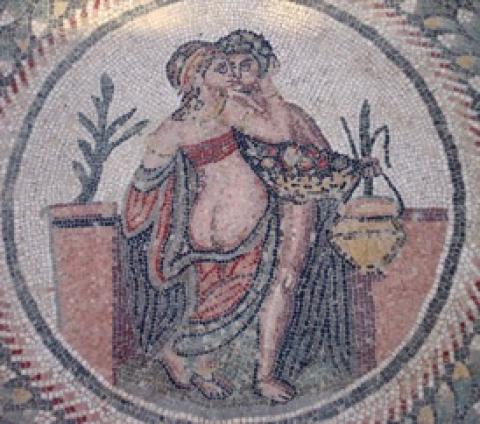Adrienne Rose
February 23, 2018
By Adrienne K.H. Rose
In her monthly column, Prof. Adrienne K.H. Rose explores issues surrounding translation within Classics. In her first edition, she addresses the challenges of picking the “right” Catullus translation. What does “right” even mean when choosing a translation for class?
Choosing the “right” translation of any Classical author for the classroom is a challenge for most teachers. What is “right” can often be dependent upon factors such as availability and pricing, particularly for students with a textbook budget. For a popular, much-translated poet like Catullus there is a wealth of English-language translations to choose from. Catullus is antiquity’s most modern poet.
His work is raunchy, moody, turbulently charged political and social commentary – my advanced Latin students called him “emo”—his carmina akin to unfiltered Facebook status updates perhaps better left unposted. At the same time they’re fastidious metrically, driven by Hellenic fascination (Grecomania?), and fixated by core human emotions and needs: internal conflict, affection, lust, mourning, and spite. Because Catullus is so contemporary, translations reinvent his persona anew with updated, contemporary language and cultural references.
Translations change because language changes. I asked a few Classicists who teach at a range of different colleges and universities to name their favourite English-language translation of Catullus to teach and why it’s their favourite. Quickly it became apparent that most traditional Classics departments teach Catullus in Latin language classes, not in translation, so [many] teachers have had little to no opportunity to choose a translation to teach. One of the benefits of a Classical literature in translation course is to invite non-majors with a range of diverse student interests and backgrounds to engage with the literatures and cultures of antiquity. Oftentimes reading Classics in translation is the gateway to a degree in Classics, as it was for me.
Julia Gaisser (Bryn Mawr) selected Jeannine Diddle Uzzi and Jeffrey Thomson’s The Poems of Catullus. An Annotated Translation (Review). As Gaisser noted, “Although there is a lot wrong with it, it has some strong points, too; and it might work well enough in some classes. I think it is aimed at a general audience, and I think the price might be within reach.” Anne Carson (NYU) and Jessica Westerhold (Tennessee-Knoxville), like many other teachers of Classics, would only be enlisted to teach Catullus in Latin. But for Carson, Celia and Louis Zukofsky’s 1969 homophonic translations of Catullus are “incomparable.” Chris Francese (Dickinson College) selected three recent translations of Catullus as most suitable for student readers (Guy Lee, Charles Martin, and Peter Green).
Peter Green’s favorite translation to teach is “of course my own!” Green prioritizes preserving Catullus’s metrics, a feat of technical virtuosity and one of the features that makes his translations attractive to teach. For Green, translating a poet like Catullus without strictly recreating the meter and rhythm is futile because, minus the music, one is left merely with a statement, not poetry. Sound is also crucial in determining the poem’s speed and pacing.
Reading multiple translations of the same poem and comparative translation analysis are productive pedagogical strategies in any classroom. Translation pedagogy highlights features and nuances of the original poem, such as rhetorical devices, metre, and allusions, as well as trends in reception history. This approach works particularly well with poem 85 (odi et amo) because it’s fourteen words long yet phenomenally rich.
For instance, I created a 2-page handout (Catullus 85: A Brief History in Translation) that collects fifteen different English-language translations of poem 85 and traces translations of the poem from the 1600s to the present. I suspect this handout could be even twice as long for poem 85 and could also work for any poem in Catullus’s corpus.
Genealogies of word choice become abundantly clear as excrucior morphs almost predictably from “torment” (Cowley 1667, Yelverton 1895, Stuttaford 1912, Cornish 1913) to “tortured” (Mulroy 2002), “on the rack” (McNaghten 1975), “fire and pain” (Gallagher 2008) “crucifixion” (Michie 1969) “nailed, through either hand” (Raphael and McLeish 1979), and “it hurts” (Copley 1969, Sesar 1974).
Anne Carson’s translations of Catullus in Men in the Off Hours (2000) are among my favourites to teach, provided that I have the opportunity to prepare students so they are familiar with traditional translations before introducing innovative versions. Carson’s odi et amo pares down the poem from fourteen Latin words to four words in translation: “hate,” “love,” “why,” and “I.” She arranges the words in such a way that preserves both the chiastic structure in the original and the poem’s emotional excrucior without even mentioning any of the overused words. Poet Brandon Brown’s translations of Catullus also invite students to discover innovative ways of reading and retranslating.
Finally, Zukofsky’s homophonic translations are polarizing for students, with some readers joyfully exclaiming at the creative possibilities while others recoil at the celebration of mis-translation in the name of art and experimentation. For Beaudelaire, David Cameron’s “Flowers of Bad” deliberately transforms Les fleurs du mal through false translation, chance operations, and errors.
As the challenges presented by Catullus translations demonstrate, teaching multiple translations and looking to translation pedagogy is one way that we can invite students to consider important facets of the original poems and translations that can productively lead class discussion beyond whether a translation is good or bad, “right” or not. In translations we make choices in the movement of a word from one language to another. As students should learn, these choices can have long-term consequences for readers (and teachers) for many years to come.
A Few Translations:
Diddle Uzzi, Jeannine and Jeffrey Thomson’s The Poems of Catullus. An Annotated Translation. Cambridge: 2015.
Green, Peter. The poems of Catullus: a bilingual edition. University of California Press: 2007.
Lee, Guy. The Poems of Catullus. Oxford: 1990.
Martin, Charles. Catullus. Yale University Press: 1992.
Zukofsky, Celia Thaew and Louis Zukofsky. Catullus (Gai valeri catulli Veronensis liber). Cape Goliard Press: 1969.
(Header Image: Mosaic from Villa Romana del Casale, Piazza Armerina, Sicilia, CC-BY-SA 2.0 via Wikimedia)
Authors


